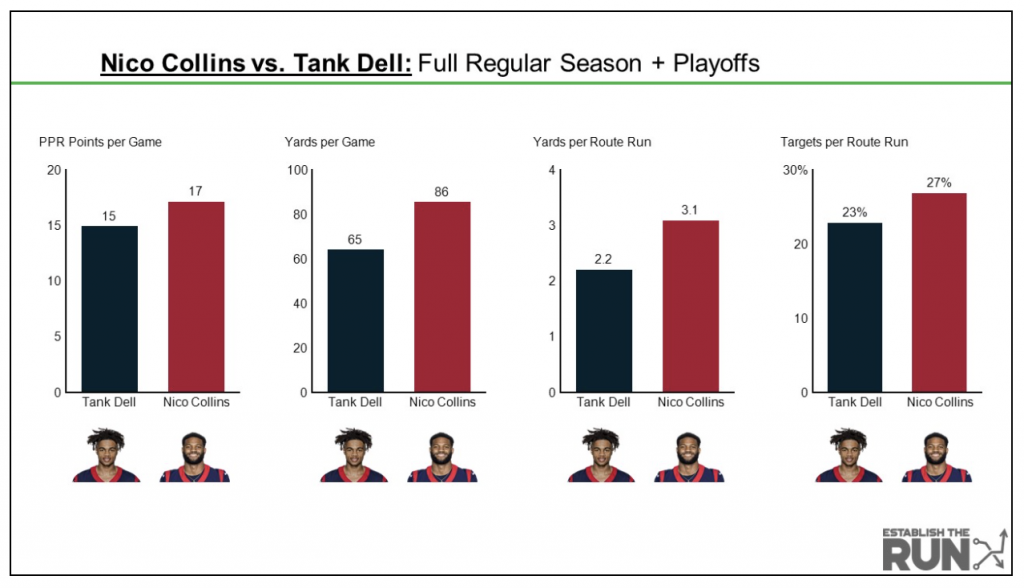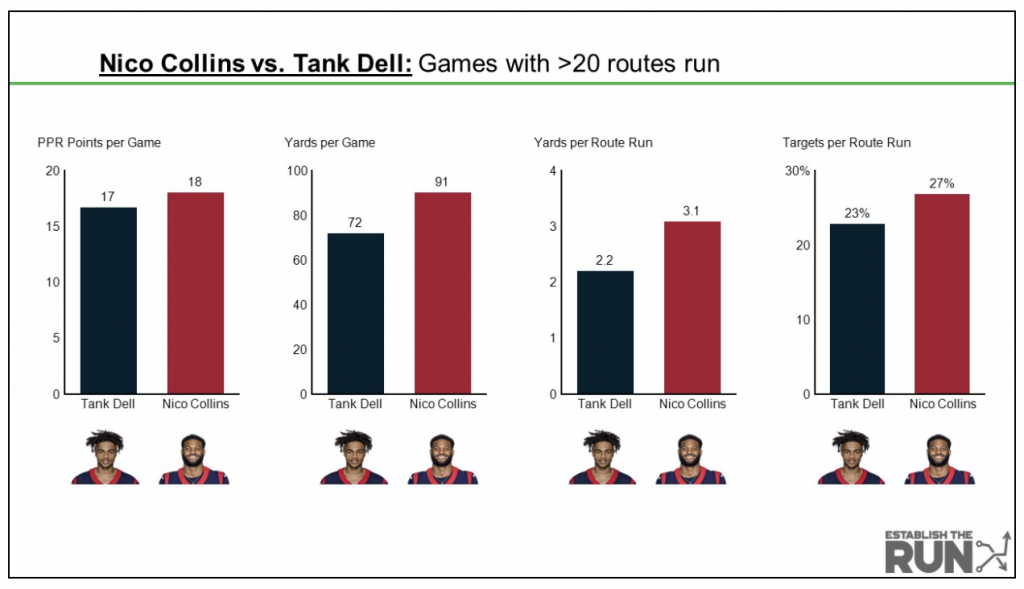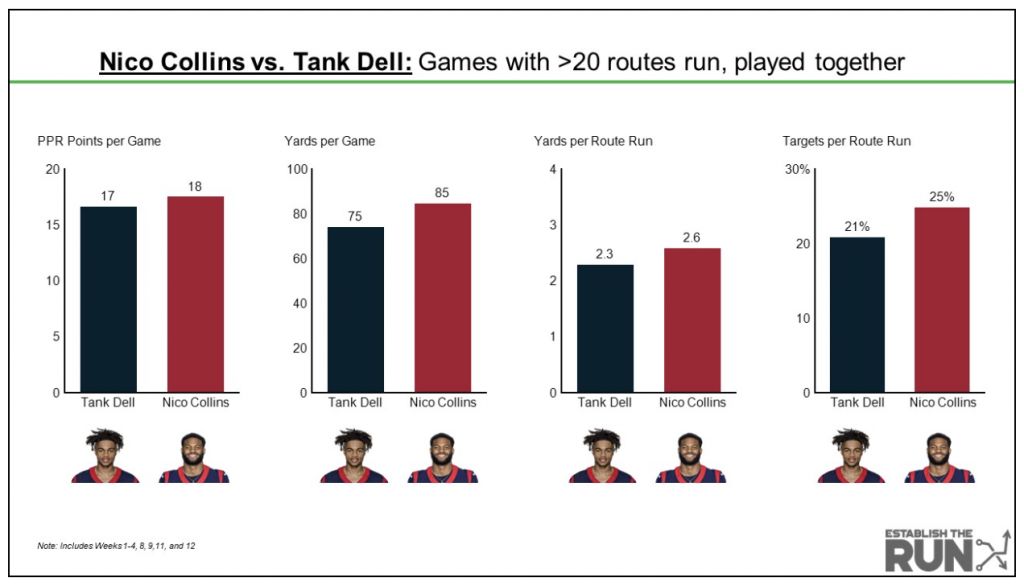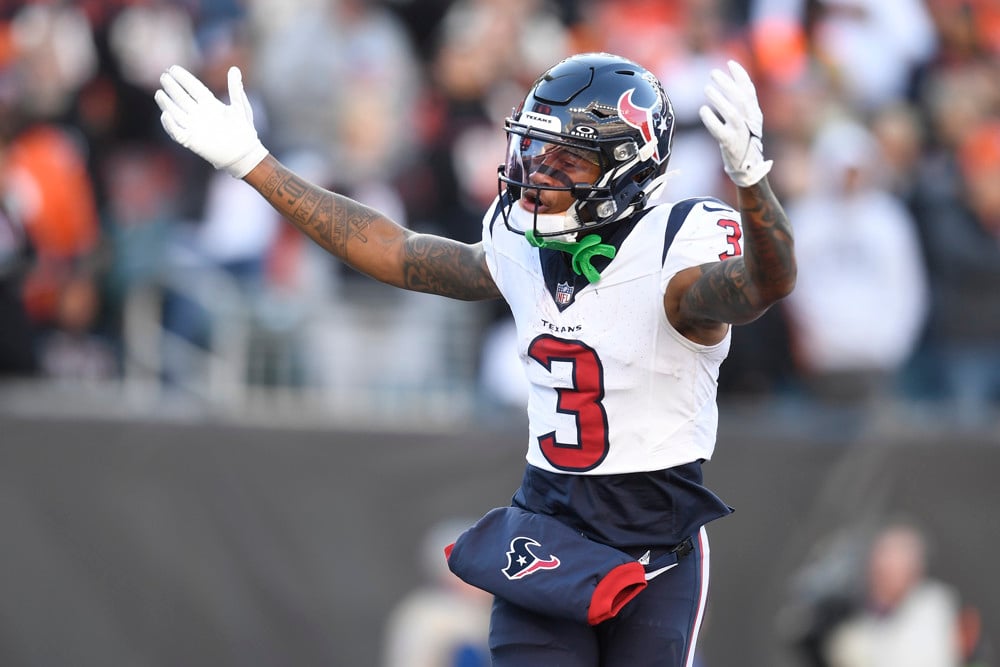ADP Deep Dives, Part I: Target Tank Dell or Nico Collins? Or Both?
The Texans’ Offensive Revitalization
In 2023, the Houston Texans rose from the ashes to become one of the NFL’s must-watch offenses. The selection of C.J. Stroud at second overall in the NFL Draft was, without hyperbole, franchise-altering. Stroud led the Texans to their first playoff victory since 2019, while throwing for the third-most passing yards of all time by a rookie QB. Stroud’s season wasn’t just impressive relative to rookie years past — he performed as one of the best QBs in the NFL in 2023. He finished third in yards per attempt, 12th in EPA/play, and eighth in fantasy points per game.
Stroud’s ascension immediately paid fantasy dividends for the Texans’ WR corps, as both rookie Tank Dell and third-year veteran Nico Collins finished as top-20 WRs in PPR points per game. Early best ball drafters are taking notice, with both Collins (ADP 16, WR9) and Dell (ADP 39, WR23) going in the first four rounds of Underdog Fantasy’s Big Board contest. Given these expensive ADPs, especially relative to where Collins and Dell were going last year, do these players have the upside to pay off their draft cost? Furthermore, is the large ADP gap between Collins and Dell justified, or should they be going closer together?
Full Regular Season + Playoff Data
Let’s start with the full picture: How did both Collins and Dell perform on a per-game and per-route basis in 2023?

Over the full-season sample, Collins edged out Dell in PPR points per game, yards per game, yards per route run (YPRR), and targets per route run (TPRR). Put in the larger context of NFL WRs, however, and it’s clear that these statistics should be interpreted more as “pro-Collins” than “anti-Dell”. For instance, 2.2 YPRR for Tank Dell is wildly impressive. That is the 10th-best YPRR of any rookie since 2013, and the 15th-best mark amongst all WRs in 2023.
Collins’ mark of 3.1 YPRR is just…even more insanely good. Since 2013, there have been only four WRs to post more than 3.0 YPRR: Julio Jones (2015, 2016, and 2017), Tyreek Hill (2022 and 2023), Cooper Kupp (2021), and Nico Collins. Any time a stat puts you in the company of Julio Jones, Tyreek Hill, and Cooper Kupp, you’re probably a good ball player.
Those who prefer Tank Dell, however, may fairly point out that Dell left several games early, slightly skewing his statistics. What happens when you filter out games where players ran less than 20 routes?
“Healthy” Games Only (>20 Routes Run)

After removing games where Collins and Dell ran less than 20 routes, the gap between Dell and Collins tightens, though Collins still has a sizable edge in several categories. From a fantasy points standpoint, Collins’ edge is attributable to yardage, where he averaged a whopping 91 yards per game after removing Week 14, which he left early due to injury. Dell actually performed slightly better in the TD column, which is on one hand impressive for the 5-foot-8 rookie, but it is also less sticky on a year-to-year basis than yardage.
The final claim for the Dell > Collins proponents is that Collins’ statistics are artificially inflated because he played many games without Dell. With weaker target competition like Robert Woods, Noah Brown, and John Metchie, it was easier to put up gaudy numbers. To assess this argument, let’s see how Collins and Dell stack up in games played together.
Collins vs. Dell “Head-to-Head”

Once you account for games where Collins or Dell were out or left early, they played just eight weeks together: Weeks 1-4, 8, 9, 11, and 12. In those games, Collins still edged out Dell in PPR Points per Game, Yards per Game, YPRR, and TPRR. The gap is closer, however, offering some merit to the argument that Collins’ stats are inflated in games where he’s not playing alongside Dell. That shows up in Collins’ YPRR and TPRR figures, which decline from 3.1 to 2.6 and 27% to 25%, respectively, when Dell is in the lineup. Interestingly, Collins’ fantasy production in terms of PPR Points per Game does not take a hit when Dell is in the lineup. This is perhaps explained by the presence of Dell leading to longer drives and increased scoring chances for the Texans, which offsets Collins’ slight reductions in per-route efficiency. In other words, it’s not clear that the presence of Dell harms Collins. Collins still offered near-elite fantasy production even when Dell was healthy.
Zooming Out: Other Factors to Consider
- Age: Despite Collins entering the NFL two years before Dell, they are only about six months apart in age due to Dell playing five years of college football. As a result, there is less of an age-based argument in favor of Dell as there typically would be for a second-year player vs. a fourth-year veteran. However, targeting second-year breakouts has historically been a strong strategy in fantasy football. That explains why drafters are eager to take Dell in the fourth round of early best ball drafts, despite some other risks in his profile, including injury. Speaking of injury…
- Size: At the NFL Combine, Tank Dell measured 5-foot-8, 165 pounds. I had a physical in December and I measured in at 5-foot-11, 175 pounds. Nico Collins, on the other hand, towers over both Tank and I, standing at 6-foot-4, 215 pounds. I’m not interested in rehashing the decades-long debates of small vs. big WRs, but I do still think it’s been widely established that bigger WRs have more upside for elite fantasy seasons. If one of Collins or Dell can score 15+ TDs in a season, I’m banking on the guy who is eight (eight!) inches taller.
- Injury history: Dell suffered a fractured fibula in Week 13, ending his season. On the spectrum of season-ending injuries, fractures are typically less worrisome than ligament damage (ACL, Achilles, etc.). However, all season-ending injuries introduce some risk that players take time to return to their pre-injury form. While I’m cherry-picking an example here, Tony Pollard suffered a leg fracture in 2022 and seemingly never returned to form in 2023, posting the worst efficiency numbers of his career. In conclusion, I’m not overly worried about Dell’s injury, but I will be closely monitoring offseason reports to see if he’s progressing on schedule.
- Target Competition Uncertainty: In 2023, the Texans’ third-, fourth-, and fifth-leading receivers (after Collins and Dell) were Dalton Schultz, Noah Brown, and Robert Woods. Both Schultz and Brown are free agents, while Woods is a cut candidate given his lack of production and guaranteed money. The Texans are projected to have $57M in cap space, meaning they will have the ammo to pursue additional help at pass catcher if they so please. As of now, it’s difficult to predict if Collins/Dell will have worse or better target competition relative to 2023. There are certainly scenarios in which Schultz, Brown, and Woods all depart and the Texans choose to spend their money elsewhere, freeing up Collins and Dell to have even larger target share ceilings. As a comparison, think of the Miami Dolphins’ offense, where Tyreek Hill and Jaylen Waddle dominate targets without any semblance of receiving talent at WR3 or TE. However, there’s also a risk that the Texans take a stab at the highly talented 2024 WR draft class, or pursue one of the big-name free-agent WRs that could become available, like Tee Higgins or Marquise Brown. I think the most likely scenario is somewhere in the middle, where the Texans bring back Schultz and add a few depth pieces at WR that are comparable in talent to Noah Brown and Robert Woods. In conclusion, the current unknowns in the Texans’ WR/TE depth chart introduces some volatility to Collins and Dell’s projections, but they are talented enough to not be overly worried about target competition that could be brought in.
Conclusion: Buy Both Collins and Dell at Current ADP
In fantasy football, we love to debate WRs on the same team, as if you have to pick a winner and loser. And if you had to pick a winner and loser between Nico Collins and Tank Dell, it’s quite clear to me that it’s Collins.
But we don’t have to pick between them! If you’re concerned about two WRs from the same team going high in fantasy drafts, the data suggests that “team WR2s” are not suboptimal draft picks. I am 100% fine being in on both Collins (ADP 17) and Dell (45) in 2024 at their current draft costs.
In targeting Collins, you are drafting a player that flashed one of the highest per-route efficiency seasons in NFL history, matched only by future Hall of Famers like Julio Jones and Tyreek Hill. In targeting Dell, you are drafting a player that had a historically good rookie season by almost any receiving metric. In drafting both of them, you are taking a receiver tied to C.J. Stroud, who awoke a franchise from a Deshaun Watson-induced coma by posting one of the best rookie quarterback seasons of all time. Unless the ADPs get out of control, the Texans’ passing offense is not one that I want to fade due to the odds of Stroud taking another leap in 2024, which we often see with second-year signal-callers.
How I’m playing it in early best ball drafts:
- Buy Nico Collins (ADP 16) over players like Jonathan Taylor (14) and Garrett Wilson (13)
- Rationale: For Nico Collins vs. Garrett Wilson, I prefer buying the player who is: A) tied to 22-year-old C.J. Stroud instead of 40-year-old Aaron Rodgers B) has an offense coordinated by Bobby Slowik instead of Nathaniel Hackett and C) has flashed a higher ceiling at the NFL level. To prefer Wilson, you have to put a lot of faith in a 40-year-old QB coming off an Achilles tear, and believe that Wilson’s target share numbers can scale to a much higher volume, an assumption that doesn’t always hold true (see: 2022 to 2023 Drake London). For Jonathan Taylor, I think the cap that Anthony Richardson puts on his upside through A) stealing goal-line work and B) choosing to scramble instead of checking down is not accurately reflected at an ADP of 14 overall.
- Why I Could Be Wrong: The case against Nico Collins is that he was, more or less, a one-year wonder. Even dating back to his college years, he was a relatively inconsistent producer until C.J. Stroud came along. Furthermore, you could argue that Tank Dell could take a leap in his second year, relegating Collins to 1B duties. Although I outlined why I believe the gap between Collins and Dell is justified, I don’t think it’s impossible that Dell could be the better player long term and cap Collins’ upside.
- Breaking Point: I have Collins ranked at 13th overall. I would start to get hesitant about drafting him if he starts to go ahead of WRs who have proven a high ceiling over a larger sample size (Amon-Ra St. Brown and A.J. Brown) or young RBs with massive pass-catching upside (Jahmyr Gibbs, Bijan Robinson, and Breece Hall). I doubt the market will ever value Collins that highly, however, so I expect to be slightly overweight based on his current ADP.
- Buy Tank Dell (ADP 39) over players like DeVonta Smith (38), James Cook (37), and Patrick Mahomes
- Rationale: DeVonta Smith is an awesome player, but the presence of A.J. Brown and Jalen Hurts‘ scrambling tendencies limit his volume upside. James Cook is capped by the presence of Josh Allen at the goal line. Patrick Mahomes is perhaps the best QB of all time, but until the Chiefs overhaul their WR room, I believe he’ll be slightly over-drafted in fantasy relative to pocket passers you can get much later (Matthew Stafford, Brock Purdy, Tua Tagovailoa, etc.).
- Why I Could Be Wrong: Tank Dell’s diminutive size makes him an extreme outlier. Critics could point to his season-ending injury as evidence that he can’t hold up to a full NFL season, or shouldn’t be a full-time player because he can’t handle blocking duties. Furthermore, the Texans could upgrade their talent at WR3/4, which could eat into Dell’s target share. It’s possible to argue from Dell’s spotty prospect profile that he was propped up by Stroud and could be usurped if further talent is added to the roster.
- Breaking Point: I currently have Dell ranked 31st overall, so I’m willing to buy him up until the mid-third round. I would start to get hesitant if he goes ahead of veteran WRs like Keenan Allen and Davante Adams, who have much higher target share ceilings and didn’t show significant signs of slowing down in 2023.


